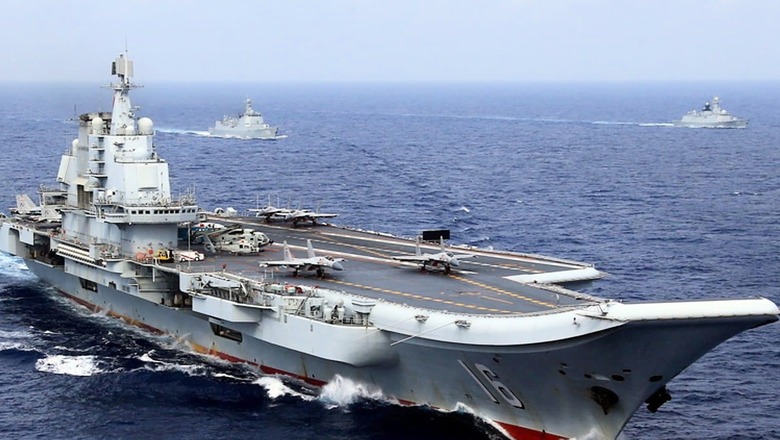
views
With much pomp and pageantry, China launched its third aircraft carrier this month. The Type 003, now named Fujian, is China’s biggest, most modern and most powerful aircraft carrier. At 80,000 tons and 318 meters, the Fujian outstrips all but America’s supercarriers, the new USS Gerald R. Ford-class. The vessel is named Fujian, after the Chinese province that sits across from Taiwan. This is China’s third aircraft carrier and second indigenously produced carrier after Liaoning and Shandong. The prior was purchased from Ukraine and commissioned in 2012, while the latter was manufactured in Dalian Shipyard and commissioned with the People’s Liberation Army Navy (PLAN) in 2019. Besides power projections in the near seas (Yellow Sea, East China Sea and the South China Sea), both Liaoning and Shandong are essentially classified as training ships and are intended to allow the Chinese Navy to experiment, train and gain familiarity with aircraft carrier operations — a relatively new domain for the People’s Liberation Army (PLA).
Fujian’s Technological Advance
Liaoning and Shandong featured what is known as a “ski jump”, a ramp at the bow of the ship that helps jets take off from the carrier’s short runway. The ski jump launches are extremely restrictive as they impose big constraints on the size, weight and payload of the aircraft being launched. However, Fujian is reported to have electromagnetic catapult launch systems (EMALS). Its main advantage is that it accelerates the aircraft more smoothly, putting less stress on their airframes. Furthermore, it weighs and costs less and also requires less maintenance than a steam piston-driven system. It also reduces the carrier’s requirement for fresh water, thus reducing the demand for energy-intensive desalination. Most US carriers have steam-driven catapults except the new USS Gerald Ford class. The reported deployment of EMALS on Fujian helps China catch up with the US in some aspects of conventional military technologies. However, like US carriers, the Fujian will not be nuclear-powered, meaning its speed, endurance, and long-ranged operational capabilities would still be limited. This also implies that Fujian would have to be supported by logistics basing and logistic support ships if it eventually has to operate beyond the three seas in the Indian Ocean Region or the Western Pacific Ocean.
Fujian is widely expected to house the upgraded J-15 fighters and could probably also host the new stealth J-35 fighter jets. Besides these, the EMALS would help it carry early warning and control aircraft and bomber aircraft besides drones and rotary-wing vessels. The vessel will have to undergo at least two-three years of sea trials before being completely operational and combat-ready. So the estimated timeline for its operational deployment could be around 2025.
China’s Carrier History and Strategy
In 2015, the South China Morning Post published a series of articles revealing the extraordinary pre-history of China’s carrier programme. The crown jewel of the Chinese Navy, the Liaoning, was, in fact, originally purchased by a Chinese businessman, Xu Zengping, at the private urging of PLAN officers but with no official backing from the Chinese Government or the Chinese Communist Party (CCP). Thus, the assertive maritime posture, which China today underplays and labels as “safeguarding overseas interests,” (维护海外利益安全, weihu haiwai liyi anquan) originated partly due to the nationalism and entrepreneurship of a Chinese businessman and a group of freelancing military officers.
The PLAN has come a long way from this, now becoming a three-aircraft carrier navy. It also has the world’s most naval vessels surpassing the US by 351 to 297. Some authoritative Chinese reports suggest that China has already started the work for building the next aircraft carrier, Type 004, which could possibly be a nuclear-powered carrier. However, there is no concrete evidence to support this claim. It reportedly plans to have six aircraft carriers by 2049 to be a world-class force and become a blue water navy to protect and pursue overseas interests.
China’s aircraft carriers are not designed for a Taiwan reunification campaign or to have a direct role in a conflict with big powers like the US or India in the Taiwan Strait, South China Sea or Indian Ocean Region. China is learning from the US’ use of carriers over the past several decades and is most likely to use them in coercing and punishing smaller powers in the near and far seas. Also, a modern navy equipped with aircraft carriers gives China a power projection capability, which was previously unavailable to them. But most importantly, the aircraft carriers will help China overcome the limits of their own geography.
The 2015 defence white paper categorically demands the PLA to develop capabilities to ensure “Near Seas Defense and Far Seas Protection.” Carriers enable naval aviation will add to the PLA’s capabilities to reach deep into the Indian and Pacific Oceans, thus enabling far-seas defence. It also provides China with capabilities to counter-attack, conduct maritime manoeuvre operations, joint maritime operations, comprehensive defence, integrated support, and maritime reconnaissance. Neither Liaoning nor Shandong have indeed crossed the Malacca Strait and sailed into the Indian Ocean yet. However, with its increasing carrier fleet and possible basing agreements to support these carriers, it could be argued that China’s permanent carrier presence in the Indian Ocean in the future is not a completely unimaginable scenario.
Suyash Desai is a research scholar specialising on Chinese security and foreign policies. He is currently studying Mandarin at National Sun Yat-sen University, Taiwan. The views expressed in this article are those of the writer and do not represent the stand of this publication.
Read all the Latest News , Breaking News , watch Top Videos and Live TV here.




















Comments
0 comment